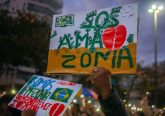In a recently published journal article, we argue that there is a pressing need for a systemisation of the impacts of COVID-19 on water, energy and food security. We also explore the tangible impacts of the pandemic, including negative aspects, like increase in medical waste, and positive aspects, like some improvements in air quality and carbon emissions.
The COVID-19 pandemic offers an opportunity to examine the impacts of system-wide crises on key supply sectors, such as water, energy, and food. These sectors are becoming increasingly interlinked in environmental policy-making and with regard to achieving supply security. Now, there is a pressing need for a systematization of impacts and responses beyond the disruptions on individual supply sectors. Specifically, this paper provides a holistic assessment of the implications of COVID-19 on the water–energy–food (WEF) nexus. The WEF nexus is a much-debated sustainability paradigm focusing on the increased integration between the water, energy and food sectors and the possible implications for resource security.
First, it integrates the academic literature related to single cases and disruptions to provide a broader view of COVID-19 demand- and supply-side disruptions and immediate effects. Then, it highlights the major, long-term impact on the categories of medicalization/hygienization, (re)localization of production, and demand fluctuations. These impacts result in cross-links that should be prioritised in a crisis, such as irrigation, energy requirements for local food production, energy use for water and wastewater treatment, or water for energy use. Finally, sector-level insights on impacts and responses are provided, drawing from illustrative cases such as the change in demand for energy for cooling in the Gulf Council Countries (GCC) and its implications for energy availability for water production (desalination).
The analysis of impacts of COVID-19 on the WEF nexus reflects the heterogeneous experiences of short-term adaptations and highlights the need to revaluate the water–food–trade nexus. Revived debates on food sufficiency can benefit from green applications to minimize expected trade-offs. The current crisis also reveals some gaps in the WEF nexus debates with regard to the lack of risk-based perspectives and the need for a better consideration of spatial aspects in resource integration, meaning that WEF nexus consideration—both in terms of potential shocks and potential solutions—should not be country-focused but consider also regional and international scales. Regarding resource-security issues in the WEF nexus, the COVID-19 stress test boosts debates concerning the adequacy of the production value chains (e.g., contingency and storage, diversification, and self-sufficiency) and the value of cross-border integration (e.g., trade, globalization, and aid).
The paper finds that research related to COVID-19’s environmental impacts has investigated individual disruptions and short terms implications, focusing on individual sectors rather than adopting holistic lenses or system approaches. However, COVID-19 is a systematic stress impacting natural resources sectors in a cross-cutting way, and therefore requires holistic and systematic analysis, including in terms of temporal and geographical scales. For this reason, this paper focuses on the water-energy-food nexus, aiming to cross-cut and capture the interlinkages of impacts of the pandemic on the whole system. The pandemic’s ramifications represent an additional layer of complexity and urgency in studying integration within the WEF nexus and its consequences on our understanding of environmental or resource-supply security. This article provides a framework for the analysis of these impacts, ensuring nuances and complexities are accounted for. We hope to promote future research and analysis that avoids simplistic and reductionists accounts of the pandemic’s impacts on natural resources.




